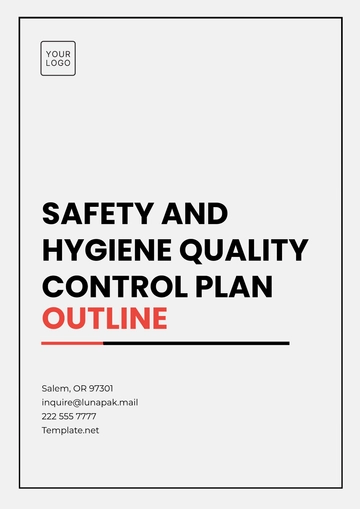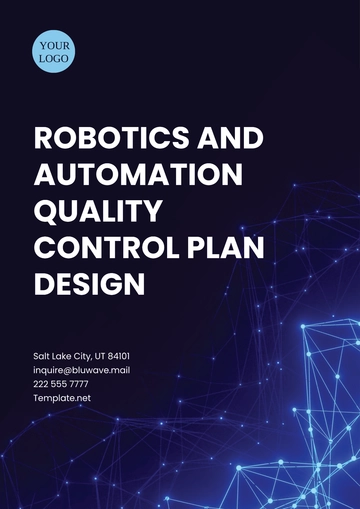Free Healthcare Facility Quality Control Plan

Prepared by:
[Your Name]
[Your Company Name]
1. Introduction
The purpose of this Healthcare Facility Quality Control Plan is to ensure the highest standard of patient care and operational efficiency. Our goal is to implement evidence-based practices and continuous improvement methodologies that align with regulatory standards.
1.1 Background
This plan is developed in compliance with national healthcare regulations and is tailored to address the specific needs and challenges of our facility. We recognize the importance of maintaining high-quality standards and the impact they have on patient outcomes and overall healthcare delivery.
1.2 Scope
The scope of this Quality Control Plan encompasses all departments and services within our facility, including inpatient and outpatient care, emergency services, and support operations. It addresses both clinical and administrative processes to ensure a holistic approach to quality management.
2. Quality Control Objectives
2.1 Enhance patient safety and satisfaction
Implement stringent safety protocols and regular staff training.
Conduct patient satisfaction surveys and act on feedback.
2.2 Optimize operational efficiencies
Streamline processes to reduce wait times and improve service delivery.
Utilize technology to automate routine tasks and improve accuracy.
2.3 Foster a culture of continuous improvement
Encourage staff participation in quality improvement initiatives.
Regularly review and update policies and procedures.
2.4 Ensure regulatory compliance and best practices
Stay updated with current healthcare regulations and standards.
Conduct regular audits and compliance checks.
3. Quality Control Methods
3.1 Risk Management
Risk Assessment: Proactively identify potential hazards through regular risk assessments.
Mitigation Strategies: Develop and implement strategies to mitigate identified risks.
Incident Reporting: Encourage staff to report incidents and near-misses to improve safety practices.
3.2 Performance Monitoring
Key Performance Indicators (KPIs): Track performance using KPIs related to patient care, operational efficiency, and compliance.
Data Analytics: Utilize data analytics tools to monitor trends and identify areas for improvement.
Benchmarking: Compare performance metrics with industry standards and best practices.
3.3 Staff Training
Ongoing Education: Provide continuous education and training programs for all staff members.
Certification Updates: Ensure all staff maintain current certifications and are knowledgeable about the latest practices and technologies.
Training Evaluations: Regularly evaluate the effectiveness of training programs and make necessary adjustments.
3.4 Patient Feedback
Feedback Mechanisms: Establish multiple channels for patients to provide feedback, including surveys, suggestion boxes, and digital platforms.
Feedback Analysis: Regularly analyze patient feedback to identify trends and areas for improvement.
Action Plans: Develop and implement action plans based on patient feedback to enhance the patient experience.
4. Roles and Responsibilities
Position | Responsibility |
|---|---|
Quality Control Manager | Oversee the implementation and monitoring of the Quality Control Plan, ensure adherence to regulatory standards, and coordinate quality improvement initiatives. |
Department Heads | Ensure departmental compliance with quality standards and protocols, lead department-specific quality improvement projects, and report on performance metrics. |
Healthcare Staff | Participate in quality improvement initiatives, adhere to established protocols, and actively engage in training programs and safety practices. |
5. Performance Evaluation
Regular Audits: Conduct regular audits of clinical and administrative processes to ensure compliance and identify areas for improvement.
Quality Assessments: Perform comprehensive quality assessments to evaluate the effectiveness of quality control measures.
Continuous Feedback: Implement a continuous feedback loop to refine and improve quality control processes.
6. Continuous Improvement
Feedback Loop: Establish a system for continuous feedback from staff, patients, and stakeholders to drive improvements.
Collaboration: Foster collaboration and communication across departments to share best practices and innovate.
Quality Improvement Committees: Form committees dedicated to quality improvement to regularly review and enhance quality control measures.
7. Conclusion
By adhering to this Quality Control Plan, our facility is committed to providing superior healthcare services and ensuring the best possible outcomes for our patients. Continuous evaluation and improvement are essential components of our approach to healthcare quality management. Through dedicated efforts, we aim to create a safe, efficient, and patient-centered environment that upholds the highest standards of care.
- 100% Customizable, free editor
- Access 1 Million+ Templates, photo’s & graphics
- Download or share as a template
- Click and replace photos, graphics, text, backgrounds
- Resize, crop, AI write & more
- Access advanced editor
The Healthcare Facility Quality Control Plan Template from Template.net is fully editable and customizable to meet the unique needs of your healthcare facility. Easily adjust the plan to ensure compliance with quality standards. Editable in our AI Editor Tool, this template offers a flexible, professional approach to maintaining high-quality care and operational efficiency.
You may also like
- Finance Plan
- Construction Plan
- Sales Plan
- Development Plan
- Career Plan
- Budget Plan
- HR Plan
- Education Plan
- Transition Plan
- Work Plan
- Training Plan
- Communication Plan
- Operation Plan
- Health And Safety Plan
- Strategy Plan
- Professional Development Plan
- Advertising Plan
- Risk Management Plan
- Restaurant Plan
- School Plan
- Nursing Home Patient Care Plan
- Nursing Care Plan
- Plan Event
- Startup Plan
- Social Media Plan
- Staffing Plan
- Annual Plan
- Content Plan
- Payment Plan
- Implementation Plan
- Hotel Plan
- Workout Plan
- Accounting Plan
- Campaign Plan
- Essay Plan
- 30 60 90 Day Plan
- Research Plan
- Recruitment Plan
- 90 Day Plan
- Quarterly Plan
- Emergency Plan
- 5 Year Plan
- Gym Plan
- Personal Plan
- IT and Software Plan
- Treatment Plan
- Real Estate Plan
- Law Firm Plan
- Healthcare Plan
- Improvement Plan
- Media Plan
- 5 Year Business Plan
- Learning Plan
- Marketing Campaign Plan
- Travel Agency Plan
- Cleaning Services Plan
- Interior Design Plan
- Performance Plan
- PR Plan
- Birth Plan
- Life Plan
- SEO Plan
- Disaster Recovery Plan
- Continuity Plan
- Launch Plan
- Legal Plan
- Behavior Plan
- Performance Improvement Plan
- Salon Plan
- Security Plan
- Security Management Plan
- Employee Development Plan
- Quality Plan
- Service Improvement Plan
- Growth Plan
- Incident Response Plan
- Basketball Plan
- Emergency Action Plan
- Product Launch Plan
- Spa Plan
- Employee Training Plan
- Data Analysis Plan
- Employee Action Plan
- Territory Plan
- Audit Plan
- Classroom Plan
- Activity Plan
- Parenting Plan
- Care Plan
- Project Execution Plan
- Exercise Plan
- Internship Plan
- Software Development Plan
- Continuous Improvement Plan
- Leave Plan
- 90 Day Sales Plan
- Advertising Agency Plan
- Employee Transition Plan
- Smart Action Plan
- Workplace Safety Plan
- Behavior Change Plan
- Contingency Plan
- Continuity of Operations Plan
- Health Plan
- Quality Control Plan
- Self Plan
- Sports Development Plan
- Change Management Plan
- Ecommerce Plan
- Personal Financial Plan
- Process Improvement Plan
- 30-60-90 Day Sales Plan
- Crisis Management Plan
- Engagement Plan
- Execution Plan
- Pandemic Plan
- Quality Assurance Plan
- Service Continuity Plan
- Agile Project Plan
- Fundraising Plan
- Job Transition Plan
- Asset Maintenance Plan
- Maintenance Plan
- Software Test Plan
- Staff Training and Development Plan
- 3 Year Plan
- Brand Activation Plan
- Release Plan
- Resource Plan
- Risk Mitigation Plan
- Teacher Plan
- 30 60 90 Day Plan for New Manager
- Food Safety Plan
- Food Truck Plan
- Hiring Plan
- Quality Management Plan
- Wellness Plan
- Behavior Intervention Plan
- Bonus Plan
- Investment Plan
- Maternity Leave Plan
- Pandemic Response Plan
- Succession Planning
- Coaching Plan
- Configuration Management Plan
- Remote Work Plan
- Self Care Plan
- Teaching Plan
- 100-Day Plan
- HACCP Plan
- Student Plan
- Sustainability Plan
- 30 60 90 Day Plan for Interview
- Access Plan
- Site Specific Safety Plan
























